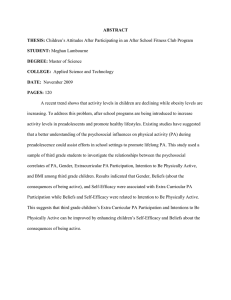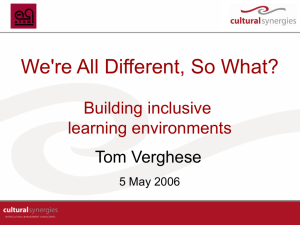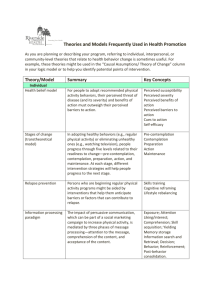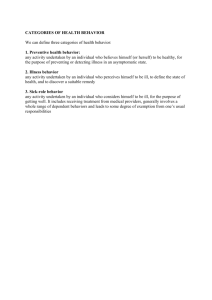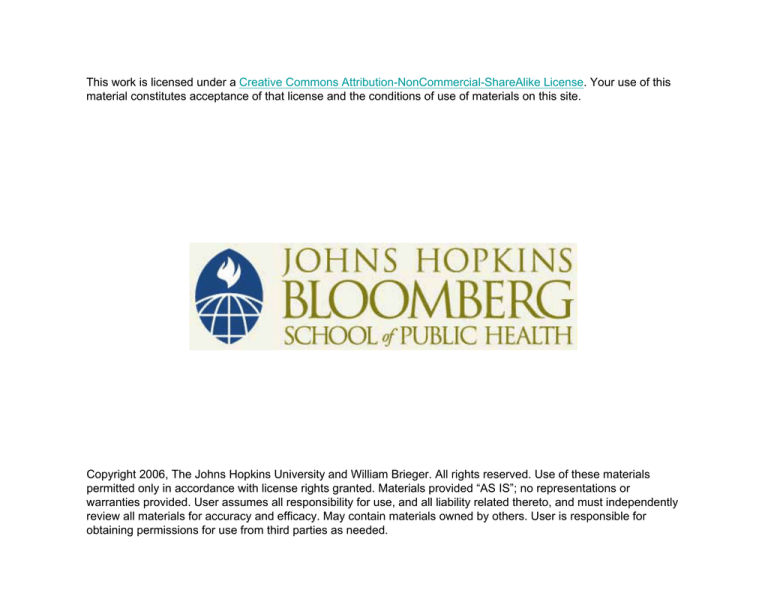
This work is licensed under a Creative Commons Attribution-NonCommercial-ShareAlike License. Your use of this
material constitutes acceptance of that license and the conditions of use of materials on this site.
Copyright 2006, The Johns Hopkins University and William Brieger. All rights reserved. Use of these materials
permitted only in accordance with license rights granted. Materials provided “AS IS”; no representations or
warranties provided. User assumes all responsibility for use, and all liability related thereto, and must independently
review all materials for accuracy and efficacy. May contain materials owned by others. User is responsible for
obtaining permissions for use from third parties as needed.
Health Belief Model,
Social Learning Theory
William R. Brieger, MPH, CHES, DrPH
Johns Hopkins University
1
Section A
Theories in Practice
2
Theories in Practice
Common Models and Theories
In Health Education Research
50
Stages
66
TRA
74
SE
74
SLT
100
HBM
0
50
100
3
The Health Belief Model
Ù Basic components
– A recommended (health) action
– Perception of (disease) threat
• Susceptibility
• Seriousness
Continued
4
The Health Belief Model
Ù Basic components
– Perceived benefits/constraints to
that action
• Perceived efficacy
• Perceived costs
– Social and structural modifiers
– Cues to action
Continued
5
The Health Belief Model
Ù Background issues
– Draws heavily on Lewin’s force
field
– Value expectancies inherent in
benefit-constraint analysis
– Decision making paradigm—Some
element of rationality, but
Continued
6
The Health Belief Model
Ù Background issues
– Key word is “perception”
– Disease threat central concept
• Need to add cultural aspect of
disease perception: What is
disease? What is illness?
7
Modifying Factors:
• knowledge “in blood”
• low econ status
• household roles
• ed levels low
Perceived
Susceptibility:
HIGH – already
in body
Perceived
Seriousness:
HIGH – disability
well known
Perceived
threat of
guinea worm
= HIGH
Cues to action:
• VHWs promote
• neighbors buy
• see g.w. sufferers
Benefits:
+ filters remove dirt
+ available (VHW)
+ elastic band easy
Constraints:
- doubt efficacy
- alternatives cheap
- 2nd rate viz wells
Likelihood
of Filtering =
Moderate -Low
8
Modifying Factors
• local knowledge
• low economic status
• HH gender roles
• social values
Perceived
Susceptibility
HIGH -causes
common, i.e.
sun, dust
Perceived
Seriousness
LOW- minor
inconvenience
Perceived
Threat
= LOW
Cues to Action
• sleepless nights
• neighbors buy net
• promotional
activities
BENEFITS
+ warmth in rains
+ privacy in bed
+ less insect nuisance
+ beautifies home
+ keeps bed clean
CONSTRAINTS
- hot in dry season
- costly
- retreatment costs too
-can’t prevent malaria
Likelihood of
buying nets Moderate
9
Modifying Factors
• access to care alternatives
• low economic status
• HH gender roles in care
• low educational levels
• household structure
Perceived
Susceptibility
moderate-low
complications
viewed as a
different illness
Perceived
Seriousness
viewed as minor
indisposition, but
parent miss work
Perceived Threat
of Malaria
complications in
child = LOW
BENEFITS
+ convenient drug shops
+ believe safe prepackaged
+ orth drugs faster,safer for child
+ saves time
CONSTRAINTS
- difficult measure dose
- herbs sweat out disease
- time waste at clinic
- some side effects - itching
Cues to Action
• VHWs promote sales
• advice from neighbors
• previous medicine experience
• mass media drug adverts
Likelihood of
Seeking prompt
treatment with CQ
product
- Moderate
10
Modifying Factors
• knowledge preg. risks
• low economic status
• age, parity occupation
• low educational levels
• household structure
Perceived
Susceptibility:
low - pregnancy
is considered
“normal”- fate or
spirits caused, if
problems
Perceived
Seriousness:
consequences
would be serious,
maternal loss
work
BENEFITS:
+ safe delivery, healthy baby
+ normal pregnancy
+ good health of mother
+ short hospital stay
Perceived
Threat of
Pregnancy
Complications
= LOW
CONSTRAINTS:
- cost of care, lack of time
- distance, transport problems
- reluctant to reveal preg.
- provider attitude? ability?
Cues to Action
• previous pregnancy
experiences
• current symptoms, feelings
• experiences of friends, sisters
• advice from mother, m-in-law
• health worker communication
Likelihood of
attending ANC in a
timely & consistent
manner is moderate
to low
11
Note
Role of Explanatory in Constructing Theoretical
Ù Beliefs about pregnancy
– Normal, keeps it hidden = Don’t
register ANC early
Ù Beliefs about malaria
– Caused by sun, heat = Nets won’t
prevent
Continued 12
Note
Role of Explanatory in Constructing Theoretical
Ù Beliefs about medicines
– Good medicines make one sweat
out the disease
– Modern medicines cause no sweat
and have side effects
Ù Beliefs about guinea worm
– In the blood = Filters can’t prevent,
remove
13
HBM Lessons
Ù Threat of guinea worm high with both
high susceptibility and seriousness
– But people do not perceive efficacy
of filtering
– Therefore, likelihood of action low
Continued 14
HBM Lessons
Ù Threat of complications during
pregnancy seen as low, as few believe
they are susceptible
– But benefits seen in attending ANC
like immunizations, drugs, social
– Therefore, likelihood of action
moderate to high
15
Section B
Social Learning / Cognitive Theory
16
Social Learning/Cognitive Theory
Environment
Person
Behavior
17
Social Learning/Cognitive
Theory: Basic Components
Ù Reciprocal determinism
Ù Environmental context
– Social, economic, geographical,
political
Ù The individual
– Personal and cognitive
characteristics
Continued 18
Social Learning/Cognitive
Theory: Basic Components
Ù The behavior
– Nature and dimensions
Ù Self-efficacy
Ù Value expectancies
19
Details on Self-Efficacy
Ù The state of belief in one’s ability is a
good predictor of motivation and behavior
Ù The person’s confidence in performing a
particular behavior
Ù Implications
– Approach behavior change in small
steps
– Seek specificity about the change
sought
20
Self-Efficacy Beliefs
Ù Self-efficacy beliefs can be enhanced
through:
– Performance mastery
– Modeling
– Reinterpretation of physiological
symptoms, and
– Social persuasion (information,
encouragement)
21
Self-Efficacy
Ù Enhanced self-efficacy leads to
improved behaviors, motivation,
thinking patterns, and emotional well
being
Ù Not concerned with the skills one has
but judgments of what one can do with
skills one possesses
Ù Also enhances perceptions of well
being as in cases of chronic illness
22
The Component Processes
Underlying Observational Learning
Ù Attention
– Including modeled events
(distinctiveness, effective valence,
complexity, prevalence, and
functional value) and observer
characteristics (sensory capacities,
arousal level, perceptual set, and
past reinforcement)
Continued 23
The Component Processes
Underlying Observational Learning
Ù Retention
– Including symbolic coding,
cognitive organization, symbolic
rehearsal, and motor rehearsal
Ù Motor reproduction
– Including physical capabilities,
self-observation of reproduction,
and accuracy of feedback
Continued 24
The Component Processes
Underlying Observational Learning
Ù Motivation
– Including external, vicarious, and
self-reinforcement
25
Motorcycle Drivers
Ù Motorcycle taxis
are a main form
of transportation
Ù Drivers don’t
wear helmets;
speed to make
more trips; carry
extra loads, etc.
26
Motorcycle
taxi drivers
Observational
Learning
other drivers,
older brothers
PERSON
•younger age
•risk taker
•gender-male
•educated, no job
ENVIRONMENT
•drivers code of conduct
•passengers demand
•regulations/enforcement
•road conditions
•community beliefs acid.
Value
•econ conditions
Expectancies
save life, waste
time/money
Self-Efficacy
feel capable
BEHAVIOR
safe driving:
proper speed,
stopping, etc.
27
Alcohol and women
28
Women
drinking
alcohol
Observational
Learning
friends, spouse,
boyfriends
ENVIRONMENT
•social norms frown on
women who drink
•available cheaply in
neighborhood, discretely
•free flow of drinks at
ceremonies on weekend
PERSON
age, marital status,
being a mother,
econ status/occu.
= purchase power,
religion
Self-Efficacy
feel capable
refusing or
moderate
Value
Expectancies
less stress,
more friends,
but bad
reputation, hurt
children
BEHAVIOR
refuse drinks or
take moderate
amounts
29
Women Are Usually Responsible
for Collecting and Filtering Water
Fitting the filter on
the water pot
Washing filter
when it’s dirty
30
Filter Use
for Guinea
Worm
Observational
Learning
VHW, watch
neighbors
PERSON
wife, mother,
low ed status,
occupation,
passive within
extended family
ENVIRONMENT
•social roles, women’s
domestic roles
•perceptions about water
quality and disease causes
•concepts of filtering/sieving
•water container designs
Self-Efficacy
feel capable of
sieving
Value
Expectancies
removes dirt,
but can’t
prevent gw
BEHAVIOR
filtering water
each time
collect from
pond
31
Breastfeeding Is Normal
in the Villages, But …
Ù Colostrum is
suspected
Ù People believe
babies, like other
people, need
water
Ù Herbal teas are
given to prevent
problems
Source: The Basics
32
Exclusive
Breast
Feeding
Observational
Learning
sisters,
mothers,
friends, nurses
ENVIRONMENT
•breastfeeding normal
•economic austerity
•extended family house
•formula advertised
•community beliefs about
herbs, baby’s needs
PERSON
age, educational
level, econ status
(afford alternative),
assertive or passive
Value
Expectancies
safe, clean,
but mother
weak, baby
thirsty
BEHAVIOUR
only give breast
milk first 4
months of life
Self-Efficacy
feel capable to BF but
not sustained EBF
33
Lessons
Ù Different configuration of
components for each situation
– EBF—unlikely because
• Doubt ability to sustain, not
enough food for oneself
• Doubt will satisfy baby
• No role models
Continued 34
Lessons
Ù Different configuration of
components for each situation
– Motorcycle driver’s safety—Might
try
• Feel capable, but
• Costs outweigh benefits
• Observe: Safer drivers are older,
already established
Continued 35
Lessons
Ù Different configuration of
components for each situation
– Filtering to prevent guinea worm—
doubts outweigh confidence
• Feel confident can filter
• Doubt filtering will prevent, takes
extra time
36


